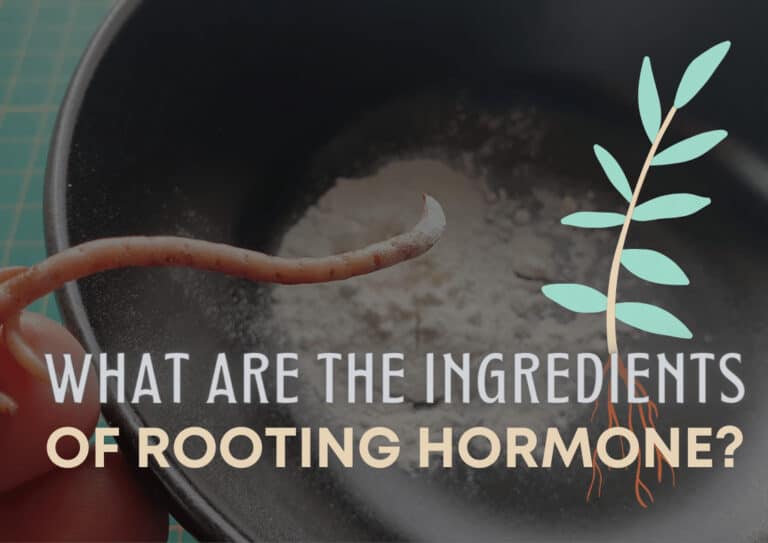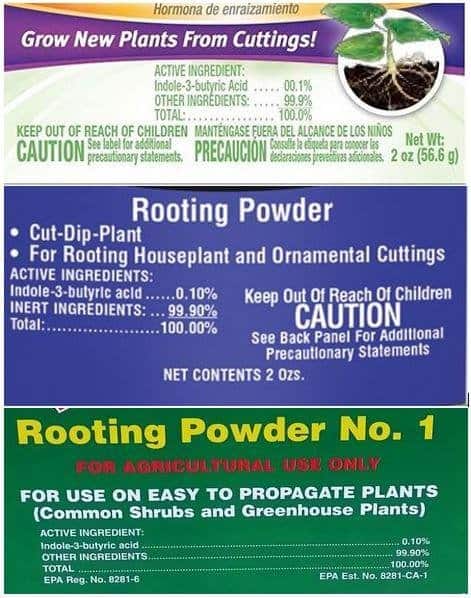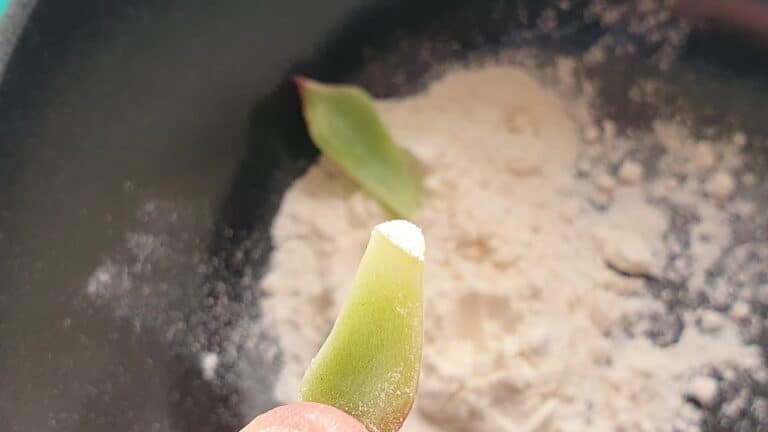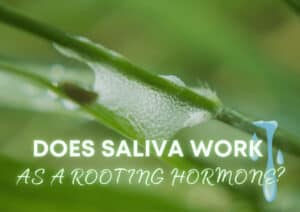What Is Rooting Hormone Made Of? [Ingredient List]
-
Chris Dosser
- January 21, 2023
If you buy something using the retail links in our articles, sometimes we earn a small affiliate commission. This does not impact the products we recommend.
Rooting hormones are commonly used by gardeners, plant lovers, growers and farmers to encourage the fast rooting of propagated plant cuttings.
The exact ingredients of a rooting hormone will depend on the brand of the product, however the most important are the active ingredients which are synthetic auxins such as 2,4-dichlorophenoxyacetic acid (2,4-D) and naphthalene-1-acetic acid (NAA) which work by mimicking naturally occurring plant auxin Indole-3-acetic acid (IAA) to promote the differentiation of cells into root tissue.
Common ingredients of a rooting hormone powder include:
- Synthetic auxins such as 2,4-dichlorophenoxyacetic acid (2,4-D)
- Cytokinins to stimulate cell division
- Fungicide such as thiram to prevent the growth of mold on the new cutting
- Silicone dioxide to help the hormone adhere to the cutting
Common ingredients of organic rooting hormone powder include:
- Willow bark: a natural source of auxin
- Cinnamon: a natural antimicrobial
- Epsom salt: a source of magnesium
- Seaweed: source of minerals
- Crushed vermiculite: to act as a binding agent
Below we’ll discuss how the active ingredients work, the uses of rooting hormones, the different types of rooting hormone, and how best to use them.

What are the active ingredients in rooting hormones and how do they work?
To understand the active ingredients of rooting hormones, let’s first look at how the naturally occurring hormones operate. These are known as auxins and play a significant role in plant growth regulation. Mostly, they initiate adventitious root growth, rather than new growth at the tips of stems, which is why synthetic hormones are often used to encourage growth in propagated cuttings.
The main active auxins in plants is Indole-3-acetic acid (IAA), with various precursors such as IBA, 4-chloroindole-3-acetic acid (4-Cl-IAA), and phenylacetic acid (PAA) that can be converted into IAA.
As you might expect there are a number of synthetic compounds that are used as growth hormones. One example is 2,4-diclorophenoxyacetic acid (2,4-D), which is mainly used in tissue culture work. Another is alpha-Naphthalene acetic acid (NAA). NAA in particular mimics IAA really well, allowing it to be applied to plants and used to encourage root growth without breaking down too quickly.
The volume of active ingredient in a synthetic rooting hormone is extremely low, amounting to only 0.1%.

What types of rooting hormones are there, and how do I use them?
Rooting hormones come in various forms but each contain the same components
Rooting Gel Hormone: To use gel hormone, you simply squeeze a little bit into a small container, then dip the cut edge of a plant cutting into it. The gel will adhere to the cut surface allowing it to immediately be placed in the appropriate rooting medium. Remember to dip your finger or a pencil into the soil first to prevent the gel from being scraped off by the potting mix as it is pressed into the soil.
Liquid Rooting Hormone: You can find liquid rooting hormone two varieties: standard strength and concentrated. The latter is typically more cost-effective, as you get more uses out of your product, but it requires more preparation. To use concentrated liquid rooting hormones, you must first dilute the solution with water before dunking the cut end of the cutting. Liquid is the best at coating surfaces and work particularly well if you’re working with a large number of cuttings at once.
Powder Rooting Hormones: Finally, there are powder rooting hormones, which are very shelf-stable. To use, you must first dip your plant cuttings in water. Then, pour some rooting hormone onto a plate and dip the wet cuttings into the hormone, so the powder sticks to the ends with ease. The excess powder should be brushed off and then discarded.
Tip! Remember to never directly dip your plant cuttings into a rooting hormone bottle or original container. As well as making a mess, this can lead to contamination and infection issues for future cuttings. Instead, always transfer a small amount of the hormone into a clean container first.

How can I encourage rooting naturally without artificial hormone?
Encouraging cuttings to root and survive without a boost from rooting hormone requires providing adequate care and a proper environment conducive to the rooting process.
First consider the time of year when attempting to grow out cuttings. In spring and summer, the plants will naturally produce more rooting hormone. In winter, however, it’ll take longer for a plant to develop roots without aid, and therefore may benefit from being supplemented with additional hormones.
Try to take cuttings in the morning, when they’ve just been hydrated, and have plenty of water so they don’t dry out too quickly.
Temperature is another crucial factor. Most cuttings will root best in 75°F to 79°F, though this will depend on the specific plant. Bottom heat from heated propagators or heated mats can help to create a suitably warm, even temperature.
Bright indirect sunlight, or grow lights where necessary, promotes fast root development.
If you’re propagating cuttings in water, use a small container so that naturally produced rooting hormones – do not get diluted. All leaves, if present, should remain out of the water to avoid rotting.
If you want to grow organic plants, you may not want to use synthetic rooting hormones, as many contain non-natural fungicides and other additives. If you wish to use organic aides, you could use cinnamon as an antifungal/antibacterial agent if you’re worried about infections.
Before you go…
These articles will help you up your propagation game to a new level:
How should you use rooting powder when propagating succulents?

Chris Dosser
Co-Founder of Eden Indoors
Chris is a self-taught horticulturist with over a decade of experience caring for houseplants and creating lush, thriving indoor oases. He specializes in Monstera, and by self admission has a serious problem with buying and propagating rare indoor plants!
Similar Posts
Is Rooting Hormone Poisonous To Cats & Dogs?
Rooting hormone is a must-have for many plant-lovers, but could it be dangerous or toxic to curious dogs and cats in your home?
Does Saliva Work As A Rooting Hormone? Examining The Science Behind The Claim
Can you use your own saliva to propagate plants? This blog article explores the science behind rooting hormones and whether saliva is a viable option.



